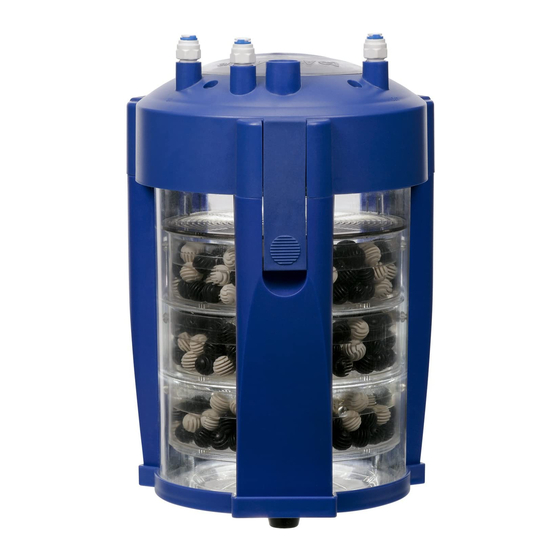Aqua Medic Nitratreductor NR Blue Instrukcja obsługi - Strona 9
Przeglądaj online lub pobierz pdf Instrukcja obsługi dla Akwaria Aqua Medic Nitratreductor NR Blue. Aqua Medic Nitratreductor NR Blue 18 stron.

3. Description of the Nitratereductor
1) of
The Aqua Medic Nitratereductor NR Blue consists of a reaction vessel (
approx. 5 l volume.
To provide surface material for the bacteria, the filter is filled with Aqua Medic Miniballs and Mini-
Deniballs. They create an ideal microclimate for denitrification.
To avoid dead zones, the water is recirculated internally in the Nitratereductor. A recirculation
pump (6) is included in the top.
In denitrifying filters, especially in units where the water has to pass through a long way, it can
occur that there is no even flow in the filter. Zones with a very low redox potential are created
where hydrogensulfide is produced (the filter starts to smell badly). On the other side, zones with a
rather high flow may arise where nitrate is reduced only to nitrite. In each case, the conditions
vary in the different zones of the filter and it is nearly impossible to find its right working point.
These unpleasant effects are avoided by the construction of the Aqua Medic Nitratereductor. The
recirculation ensures a complete mixing and the same redox potential level in the whole filter.
Zones with a very low redox potential and the production of hydrogen sulfide are avoided.
The redox potential can be used for control of the filter. The effectivity and reliability of the filter
can be increased .
Connections:
The following connections are located in the top of the Nitratereductor:
1. Inflow (10): Here, you can connect a 6/4 mm air tube. The inflow is either done in the bypass
by an adjusting tap or by a dosing pump (SP 1500) that is controlled by a timer or redox control.
The best flow rate is approx. 0.5 – 1 l/h (about 1 drop per second). The adjustion at the inflow
causes a delay until you can read the adjusted drop number at the drop counter (14). The drop
counter is mounted inside of the aquarium, close to the water level.
The flow rate may never be regulated via the outlet in order to allow produced nitrogen to escape
from the system. The inlet has an internal elongation that prevents that gases rise into the
inlet.
2. Feeding (11): Through this opening, you can inject Denimar-Powder with a syringe to
enhance denitrification. Dissolve the powder beforehand in some water. After every feeding, the
valve has to be cleaned and closed.
3. Joint for redox electrode (24): Through this opening, you can put a pressure-resistant redox
electrode (not included in shipment).
4. Outflow (12): Here, you can connect an air tube 6/4 mm, preferably, a black one to prevent
algae growth.
4. Set-Up
The Nitratereductor is a hermetically closed system. The produced gas (nitrogen and CO
) can
2
escape through the water outlet. For this reason, the outlet should never be completely closed.
The Nitratereductor has to be placed in a way that the water can flow off either directly back into
the aquarium or into the filter chamber. In a sea water aquarium, it is advantageous if the
outflowing water is flowing into the inlet of the protein skimmer or the trickling filter. In the protein
skimmer, the water is saturated with oxygen before it flows back into the aquarium.
Filter baskets:
In the Nitratereductor, there are three filter baskets (2) that are filled with filter balls. The
uptake pipe of the lowest basket has to be placed directly over the thorn at the tank
bottom. Important: The basket must not be tilted.
Before starting, the Nitratereductor is filled with aquarium water and controlled for leaking and
the right position of the sealing (7). The circulation pump can be switched on already.
9
